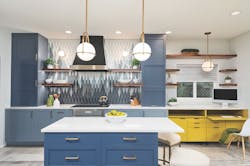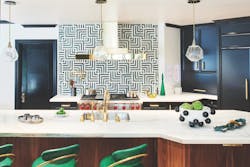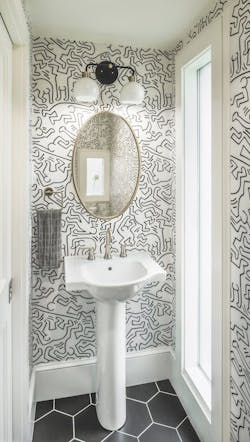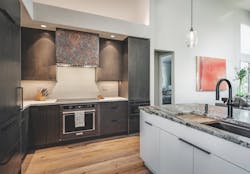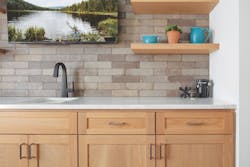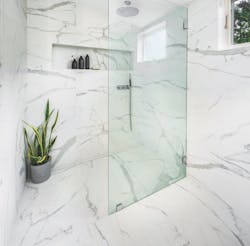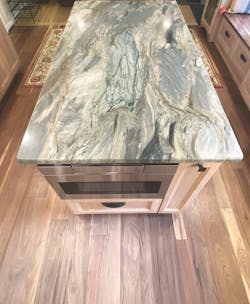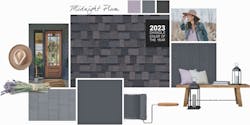Design Trends to Watch in 2024
To peer into the crystal ball of home design trends, look no further than current events.
Today’s housing market, economic conditions, and post-pandemic priorities come together to create the unique home design trends for 2024 and beyond. Anecdotal evidence and research point toward three major design aesthetics that will continue past 2024.
They are: bold personalization, throwback inspirations, and organic design.
Today’s Economic Impacts on Design and Scope
These design changes come at a changing time for the remodeling industry. Years of booming backlogs are waning with some reports predicting a challenging year ahead, while other indicators pointing toward a steady strength.
Through it all, remodelers remain cautiously positive, according to the National Association of Home Builders’ NAHB/Westlake Royal Remodeling Market Index (RMI). The index’s sentiment for remodelers’ current and future conditions came in at 65 for the third quarter of 2023, remaining above 50, the benchmark for a positive read.
Rising mortgage interest rates keep many homeowners from moving, boosting the remodeling industry. The housing stock and aging American population both sit at record high levels, according to the NAHB, setting the stage for a robust inventory of homes needing updates and older Americans needing aging-in-place remodels.
For their part, remodeling companies report a variety of homeowner behaviors, depending on the market.
“I think clients are definitely more budget conscious,” observes Julia Vandal, designer at Providence, R.I.-based Red House Design Build. “[They have] grander plans, and...will then scale down that scope based on the overall cost of projects.”
But in the DMV area, BOWA’s Lindsey Britten notices a different movement in project trends.
“Recently, people are grabbing the bull by the horns and getting everything done in one swing, rather than wanting to wait and do it piece by piece,” says Britten.
This idea of staying in a home longer than typically seen feeds into one of the fast-rising home design trends: bold personalization.
Design Trend 1: Bold Personalization
Safe choices are no longer as important to homeowners as rising mortgage rates convince more Americans to stay put. Instead, homeowners seek spaces reflecting their personal needs and style, especially in the kitchen and bath.
“They really want to make that space special to them personally,” says Designer Jen Pinto of San Diego-based Jackson Design & Remodeling. “It’s about designing spaces that inspire joy and positivity. I’m seeing the use of more bold colors and patterns accessorizing with pieces that really matter to them.”
According to the National Kitchen and Bath Association’s (NKBA) 2024 Kitchen Design Trends Report, 76% of designers agree that homeowners don’t want a kitchen like everyone else, they want a uniquely personal design.
To that end, designers note the use of more color in cabinetry, wallpaper, fun tile choices, dramatic natural stone, and interest in previously overlooked areas of a room, such as the ceiling, or in the kitchen, the ventilation hood.
“If we’re generalizing, there’s no question that there’s a return to maximalism a bit,” says Richard Anuszkiewicz, senior designer at Nashville-based Design Galleria, which does work across the country.
The biggest color trend noted by designers nationwide is the use of green in kitchens. As white kitchens continue their departure from the top rank, and even blues, though still very hot, begin a shift, green has stepped up to take over for the next few years.
“It tends to work well with many other colors in a room,” notes Vandal. “A lot of clients are liking bringing that countertop material up the wall, so you might lose an opportunity to bring color in with tile work. That color is now coming in with your cabinetry choice, giving that room new life and interest.”
Though white kitchens will always be around, hues are moving much warmer, with many designers saying taupes and beiges replace the stark whites in both cabinetry, countertops, and tile. It’s an almost seemingly direct response to the white and black palettes of the modern farmhouse aesthetic.
All designers interviewed agreed farmhouse is “out,” but according to a Cosentino trend study, just 37% of homeowners agreed with that sentiment.
In Columbus, Ohio at The Cleary Company, Project Developer Margot Sheehan says there’s been a significant uptick in wallpaper use throughout the home, whether as an accent wall in a laundry room or an entire bathroom.
“It’s not pinpointed to one particular type of client. All people are really enjoying wallpaper right now,” she says.
Even ceilings are a canvas for a bold choice, receiving more wallpaper treatment, or other architectural details, such as wood paneling.
“People are finally starting to realize that ceiling is good real estate and can make such a huge impact in your room,” notes Ebony Stephenson, owner of Designs by Ebony in Newport News, Va. “I love that.”
Tile choices veer to the side of fun too. It’s an official goodbye to standard subway tiles, according to designers, and they welcome a variety of finishes but note homeowners enjoy bringing an element of texture through tile. Overall, winning choices for tile offers a more artisan look.
“It’s really fun to see people create different patterns out of simple tiles or using more intricate mosaics that have different colors, different shapes,” says Kelly McDermott, senior interior designer at Ruby+Suede, which serves the Twin Cities. “I’m seeing a lot of that, which I love.”
Another trend that creates a memorable space is the use of large slabs as backsplashes, sometimes with the counter material creeping up the wall, or throughout an entire bathroom.
Seamless slab backsplashes have also made their way onto ventilation hoods as more and more designers and homeowners opt to treat hoods differently from the stainless steel standard. Designers note the use of stone, drywall, wood, mixed metals, or other elements to blend the hood into the surrounding aesthetic. NKBA found that 69% of designers see integrated ventilation hoods as a movement in design for the next three years.
Hoods act as another space to highlight bold natural stones that have become homeowners’ top choices for countertops that stand out.
“We’ve seen a shift in stone to more dramatic patterns, rather than vanilla whites and grays,” says Matt White, general manager and design consultant for Neil Kelly in Eugene, Ore. “The other thing that we’re seeing is a shift back towards natural stone. And that’s been really interesting. Travertine, granite, and those kinds of things that really had gone by the wayside.”
Design Trend 2: Notes of Nostalgia
Homeowners often aren’t opting for a full throwback look, but designers find more nostalgic elements that blend with current trends. A desire for adding character to a space can be met with antique-look plumbing fixtures in the popular brass finish that welcomes a natural patina, for example.
Granite is officially making its way back into the mainstream, too. NKBA found that 32% of designers surveyed say to keep eyes on granite as it becomes increasingly popular.
“Granite is very much coming back,” says Pinto. “I know it wasn’t as popular for the past years, but I feel like it’s making a comeback with different colors and different patterns.”
The desire for natural stone offering a standout look has welcomed granite back with open arms, and it’s not the only throwback style modernizing for today’s aesthetics.
The entire idea of color, warmth, and movement away from a more sterile look comes in many forms for home design today. Yet one that’s slightly unexpected for Neil Kelly’s Matt White is the use of arches and an overall softening of corners.
“The return of curves is a big conversation that we keep hearing,” agrees Anuszkiewicz. “So whether it’s just rounded corners on countertops or archways, there’s definitely this resurgence. It’s the ebb and flow of architecture. For so long, we’ve been squaring everything up, keeping it super sharp. It’s refreshing to see a rounded soft corner again.”
Wood grains are also a renewed love for homeowners rather than painted cabinets, and with the hot cabinetry shades of greens and blues, wood mixed in offers a natural balance. But no, it’s not your grandma’s cherry red cabinets.
Designers see deep walnuts on one end and a majority of white oaks, Scandinavian-inspired hues, working in minimalist spaces and earthy, organic ones.
“When we think about those days in the 70s, and even the 60s, in the mid-century modern, we then moved away from wood,” says Pamela McNally of the NKBA. “After that, nobody wanted wood. Now wood cabinetry is coming back with that whole wood grain organic look and feel, not just in cabinetry, but also in light fixtures.”
The revived love of wood grains intersects with what is likely this decade’s most popular home design theme: a connection to the outdoors.
Design Trend 3: Yep, Organic Design is Still Growing
Fresh out of lockdowns from the pandemic, the home design world coined the term “biophilia.” Four years ago you may have never heard of it. Today, you can’t escape it. Biophilia is the idea that humans possess an innate desire to connect with nature.
What this looks like are the elements of natural texture and materials, bringing outdoor elements inside the home. But it’s also about widening the actual connections to the outdoors with windows.
“I see a lot more like opening up for larger windows and allowing in more natural light,” says BOWA’s Lindsey Britten. “So bringing in those architectural elements of the plans to really capitalize on natural lighting and views if they have a beautiful backyard, or a beautiful view of a valley.”
Ebony Stephenson has opted to add larger window sills too, allowing homeowners a spot for indoor plants and herbs.
This design trend also leans toward the use of organic shapes, such as curves, as previously noted. And organic textures have been seen added to the space through natural material wallpapers.
Biophilia brings the outdoors in, but more and more homeowners want the indoor and outdoor to be one, and it doesn’t matter where they are.
“The whole indoor-outdoor trend is not just a warm weather climate,” says McNally.
Consider infusing an element of nature through lighting. Designers note an increase in lighting fixtures with wood elements, and even woven materials such as rattan.
Outside of the home, if there’s space, more and more homeowners ask for options such as a pool or guest house. And in jurisdictions that allow it, accessory dwelling units (ADUs) are just as hot.
ADUs? Open Floor Plans?
If a homeowner has the means and the ability, many opt for an attached or detached ADU as a multigenerational space or a guest room. This is especially true in coastal areas and cities where real estate is more expensive.
In San Diego, Jackson Design & Remodeling has found a dramatic uptick in ADU requests, which are now a quarter of all inquiries. Marrokal Design & Remodeling also in San Diego has noticed an increase in junior ADUs, or JADUs now at different price points.
“I can’t say that we see more of it because we’ve always had it, but we’re starting to see more middle-income projects, probably like $400,000 to $500,000 or so budget range, starting to incorporate at least the JADU into their home,” says Enrique Covarrubias, Marrokal’s director of design.
Both California-based remodelers note travel inspirations are now more common in homeowner requests. For Jackson Design & Remodeling, that’s a lot of Bali-inspired spaces. For Marrokal, there are many Middle Eastern elements coming into play.
Nine out of 10 designers will tell you the open floor plan remains king, but more remote work has meant an adjustment.
“I think a lot of people are wanting at least a defined dining space separate from their everyday dining space,” says Jen Pinto. “I think the formal dining room might be coming back.”
Whether or not that’s true, a mainstay is certainly home offices, which the majority of designers say continue to be a must. Others note these spaces work best nowadays as a flex area with an option for secondary uses.
Roofing's Role in Design
In addition to more color inside the home, homeowners seek bolder hues for their exterior as well. The importance of roofing and the array of options offered today has expanded design possibilities, and homeowners are taking note.
“Roofing has now been elevated to a design element,” says Sue Burkett, strategic marketing leader and senior color expert at Owens Corning. “The trend is that roofing is now a trend.”
Ten years ago, options were the standard brown, black, and gray. But as trends move toward color, homeowners seek roofing options to complement their overall aesthetic. Today, shingles come in greens, purples, and oranges.
“Color in general is the trend,” says Burkett. “Give me color, and I don’t want some subtle background color. I want color.”
As the stark white interiors and modern farmhouse fade into the past, those concepts exit for exteriors as well. Today, Burkett sees a major move toward dark exteriors.
And contractors have a leg up when well-versed in the options on the market, coming in with the ability to assist their clients in selecting the best hues or aesthetics for their siding. Manufacturers, such as Owens Corning, offer visualization tools and style guides to assist you and your clients in making informed decisions.
